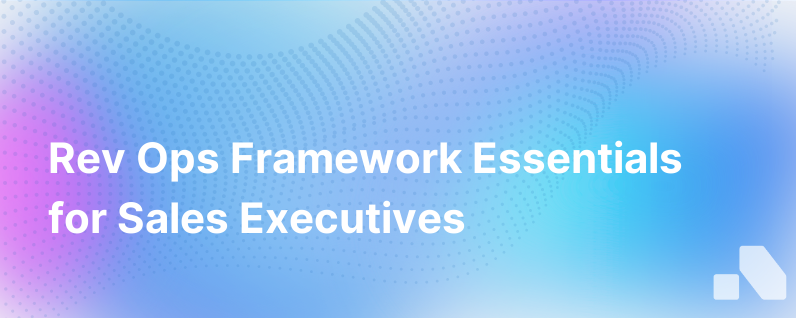
As we race into an ever-evolving business landscape, companies are seeking novel ways to accelerate growth and streamline their operations. One key strategy that has emerged as a game-changer for organizations across industries is the implementation of a Revenue Operations (RevOps) Framework. This integrative approach goes beyond traditional sales optimization, aligning marketing, sales, and customer success to drive sustainable revenue growth.
Understanding the breadth and depth of a RevOps Framework can empower your business to reach new heights. Let's delve into the domains of RevOps, its significance, and how you can seamlessly embed it into your organization's DNA.
RevOps: A Symphony of Alignment
The concept of RevOps is analogous to an orchestra, where marketing, sales, and customer success are the different instrument sections. These teams, when perfectly in tune, can create a harmonious symphony that resonates with customers and drives growth. The RevOps framework is the conductor, ensuring each section plays the right notes at the right time.
At its heart, a RevOps Framework seeks to foster a unified revenue process by strategically knitting together these three crucial departments. This amalgamation not only simplifies the complicated nexus of tools and teams but also enhances data integrity, equipping businesses with fine-grained insights.
Key Pillars of a RevOps Framework
1. Process Alignment
Process alignment creates a seamless workflow between marketing, sales, and customer success. It identifies and eliminates redundancies, ensuring a smooth customer journey from initial prospect touchpoints to ongoing engagement with existing customers.
Integrating Operations
- Lead Management: Establishing clear criteria for lead scoring and routing ensures that prospects are handed to the right department at the right time, significantly increasing conversion rates.
- Lifecycle Stages: A deep understanding of customer lifecycle stages is vital. By defining specific stages, teams can deliver tailored content and interactions that nurture relationships through each phase.
2. Data Integrity and Management
Data is the bedrock upon which successful RevOps strategies are built. Immaculate data collection, organization, and analysis enable precise targeting and personalized experiences.
Building a Data-Driven Culture
- Centralized Analytics: Having a single source of truth that amalgamates data across platforms provides visibility and consistent metrics.
- Predictive Analysis: Leveraging AI and machine learning for predictive analytics can forecast sales trends and help in resource allocation.
3. Technology Stack Optimization
A harmonized technology stack ensures that all teams have access to the tools they need to execute their strategies effectively.
Streamlining Tech
- CRM Integration: Ensure all customer data flows seamlessly into your CRM system. The CRM should act as the central nervous system of your RevOps framework.
- Marketing Automation: Utilize automation tools that sync with the sales and customer success stack to capture and nurture leads efficiently.
4. Change Management and Culture
Implementing a RevOps framework involves significant organizational change. It requires cultivating a culture that embraces collaboration and ongoing learning.
Driving Organizational Change
- Training: Offer continuous training to keep teams abreast of best practices and tools within the RevOps framework.
- Communication: Foster transparent communication channels to keep every team updated on changes and obtain feedback for improvements.
Implementing Your RevOps Framework
Analyze Current State
Begin with a thorough review of your existing processes, identifying silos and inefficiencies. Evaluate the success and shortcomings of your current workflows.
Set Shared Goals
Establish overarching revenue targets that unite marketing, sales, and customer success. Shared KPIs incentivize cooperation and collective problem-solving.
Develop an Execution Plan
Detail the steps needed to integrate your teams and systems. This may include new roles, such as a RevOps manager, to oversee and coordinate efforts.
Continual Iteration and Optimization
RevOps is not a 'set-and-forget' system. It thrives on continuous assessment, tuning, and agility to respond to ever-changing market conditions.
Measuring RevOps Success
Revenue Metrics
Keep a pulse on revenue-related metrics like customer acquisition cost (CAC), customer lifetime value (CLTV), and sales cycle lengths to gauge the health of your RevOps framework.
Qualitative Feedback
Quantitative data is crucial, but don't overlook qualitative insights. Regular feedback from teams and customers provides a fuller picture of your RevOps impact.
Challenges and Solutions
Siloed Teams
Break down barriers by clarifying roles, establishing cross-functional meetings, and fostering a collaborative culture.
Data Disparity
Invest in technologies and systems that centralize data access and analytics, ensuring that decisions are data-led and unified across departments.
Change Resistance
Manage resistance by highlighting the benefits of a RevOps framework, providing comprehensive training, and actively involving teams in the transition process.
Conclusion
The integration of a RevOps framework is an initiative that demands attention, commitment, and sustained effort. But when executed correctly, it not only creates a robust conduit for revenue growth but also crafts an environment of synergy and coherence across all revenue-generating arms of the enterprise.
Remember, the journey towards a complete RevOps model is iterative and evolutionary. Start with foundational elements and build upon them as your organization matures. As complexity grows, your RevOps framework will serve as the navigational chart guiding your voyage towards a seamless and efficient revenue-generating engine.
When forged with precision, powered by accurate data, and orchestrated with steadfast resolve, a Revenue Operations Framework can be the pivotal force driving your business forward, charting a course for relentless growth and operational excellence. Embrace this framework, and let the virtuoso performance of your teams' united efforts ring out in the annals of your company's history.